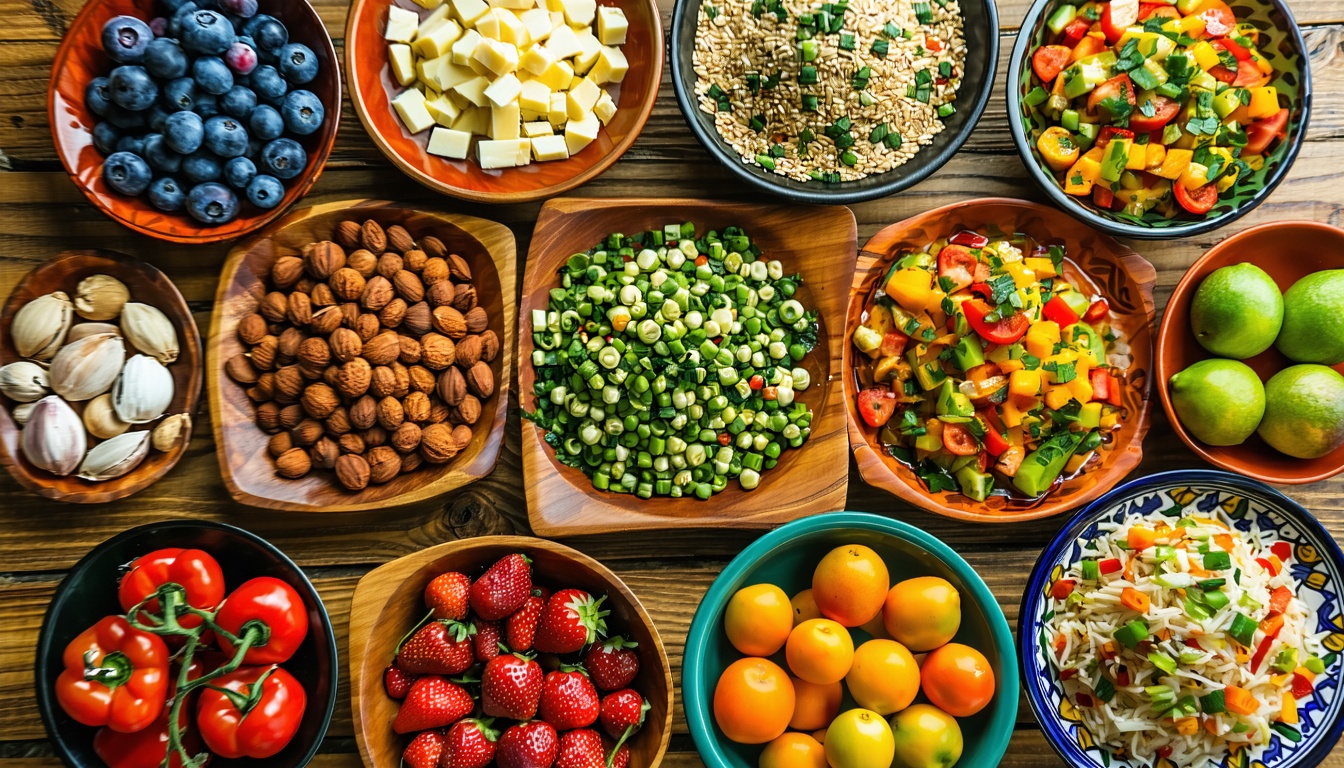How We Enjoy Cultural Cuisine While Managing Diabetes
Explore cultural cuisine to manage diabetes with local foods. Join us on a flavorful journey towards balanced health!
Cultural Cuisine: Managing Diabetes with Local Foods
Living with diabetes and still savoring your favorite cultural foods? Absolutely doable! We can keep our bonds with our heritage strong and keep our health in check.
Nodding to Old-School Ingredients
Cultural foods are chock-full of ingredients that pack a punch in nutrition. Great news for folks with diabetes. Imagine munching on nutrient-packed veggies that help control blood sugar.
Check this out: The CDC mentions that African American “soul food” works leafy greens like collard greens, mustard greens, kale, and spinach into meals. These leaves do wonders for blood sugar ’cause of their fiber boost and low-carb vibe.
Latin American chow loves quinoa. This little grain-like seed is fiber-rich and full of healthy goodness, perfect for those keeping tabs on their blood sugar. Tip: Use it as a sidekick or the star player in salads and bowls (source).
In all sorts of global eats, beans, peas, and lentils play leading roles. They pack protein and fiber way up high, which is a win for blood sugar control and cutting cholesterol. You’ll see these famous ingredients in African American, Hispanic, and Indian dishes (source).
Here’s the scoop on these superstar ingredients:
| Ingredient | Cuisine | Benefit |
|---|---|---|
| Collard Greens | African American | Lots of fiber, low in carbs |
| Quinoa | Latin American | Fiber-rich, nutrient-heavy |
| Lentils | Indian | High in protein and fiber |
Tweaking Hometown Recipes
Giving a diabetes-friendly twist to your favorite recipes is a piece of cake. Natalie Carabeo, a Latina dietitian, suggests striking the right balance on your plate, watching portions like a hawk, and staying active to hit those health goals, all while enjoying the grub you love (Beyond Type 1).
Here’s how to jazz up traditional recipes:
- Portion Smarts: Smaller bites of high-carb stuff like rice or pasta mixed with mountains of veggies and lean proteins keep blood sugar in check.
- Ingredient Swaps: Step up your game with high-fiber goodies. Think quinoa over white rice, or whole grain kicks instead of white bread.
- Cookin’ Tips: Grill, bake, or steam rather than fry for meals that are easy on the calories and fat.
Wanna keep enjoying cultural cuisine to manage diabetes with local foods? Peek at our guide on top diabetic-friendly destinations and dive into understanding medical facilities abroad.
By mixing in beloved ingredients and tweaking dishes just a tad, we’re rocking cultural food love while ruling our diabetes game.
Diabetes-Friendly Cuisine
Diving into local flavors while managing diabetes doesn’t have to leave us feeling deprived. Here’s how we’re relishing diabetes-friendly eats from all corners of the globe.
Latin American Delicacies
Latin America dishes up a colorful mix of foods that taste great and are kind to our diabetes management goals. Quinoa takes center stage in this area, popping up in many dishes. Packed with fiber, quinoa’s a powerhouse for folks keeping an eye on their blood sugar.
Here’s a peek at some top Latin American foods and why they’re worth a bite:
| Food | Nutritional Perks |
|---|---|
| Quinoa | High fiber, helps manage blood sugar |
| Avocado | Sugar-low, full of good fats, fiber-rich (Healthline) |
| Black Beans | Protein and fiber-high, low-fat |
| Green Plantains | Low on the glycemic scale, bake ’em instead of frying |
Choosing these goodies lets us savor Latin American zest minus the guilt trip.
European Culinary Classics
Europe’s no slouch when it comes to diabetes-friendly solutions. With a plateful of traditions, it’s all about clever swaps to make those iconic bites healthier.
Here’s how we give our European favorites a healthy spin:
- Ditch regular pasta for whole-grain or lentil kinds: Extra fiber, bonus protein.
- Opt for sprouted or whole-wheat bread: These have a softer impact on blood sugar than white bread.
- Keep an eye on portions: Smaller servings help keep sugar levels steady.
| Dish | Smart Swap |
|---|---|
| Regular Pasta | Whole-grain or lentil-based pasta |
| White Bread | Sprouted grain or whole-wheat bread |
| Cream Sauces | Tomato or veggie sauces instead |
These swaps mean we can still dig into those pasta and bread delights with our health intact (Beyond Type 1).
By rocking traditional ingredients and tweaking homegrown recipes, we stay rooted in cultural flavors while giving diabetes a backseat. For more on dealing with health needs when globetrotting, wander over to our guide on understanding medical facilities abroad.
Healthy Eating Strategies
Managing diabetes while enjoying tasty foods from around the world doesn’t have to be dull and dreary. With the right tricks up our sleeves, we can savor amazing flavors and keep our blood sugar chill.
Portion Control Tips
Watching how much we eat is a biggie for dealing with diabetes, especially when munching on rich and yummy dishes. Here are some handy tricks:
- Tiny Plates, Big Tricks: Using smaller plates makes everything look bigger, tricking our minds into being satisfied with less.
- Measuring Is Key: Let’s not play a guessing game; measuring our food keeps things real. Say, our rice should be about fist-sized.
- A Little Bit of Everything: Mixing it up with some protein, hunger-busting veggies, and whole grains helps keep our blood sugar steady.
| Food Item | What to Dish Out |
|---|---|
| Rice | 1/2 cup cooked |
| Pasta | 1/2 cup cooked |
| Meat or Fish | 3 ounces (about the size of a deck of cards) |
| Non-starchy Veg | 1 cup raw or 1/2 cup cooked |
Keeping an eye on portions means we can dive into all sorts of flavors without going overboard.
Ingredient Substitutions
Swapping ingredients out in our favorite cultural dishes can keep them diabetes-friendly and super tasty. Check out some swaps:
- Gobble Gobble: Switch out fatty meats with skinless turkey breast—lower fat, same yum factor.
- Fab Faux Rice: Cauliflower rice steps in for the beloved white rice, offering less carbs and more fibers (CDC).
- Pasta Switcheroo: Swap out regular pasta for whole-grain or lentil pasta, upping that fiber game.
- Dairy Dilemma: Opt for low-fat or non-fat dairy; all the yum, minus the extra calories.
For European eats, Kristin Neusel advises us to choose sprouted or whole-wheat bread over white. Just make sure “whole” is on the label for the good stuff (Beyond Type 1).
Bending these tricks to our needs means we can chow down on our fave cultural eats while staying on top of our health.
Impact of Food Insecurity
Relationship Between Diabetes and Food Insecurity
Food insecurity’s not just something you’ll shrug off when managing diabetes; it’s a big deal that hits hard for many folks. If you’re in a household struggling with food, you’re more likely to run into serious issues with diabetes. In fact, around 16% of people living with diabetes say food insecurity is part of their life, compared to 9% who don’t have diabetes.
The mess between diabetes and not knowing where your next meal is coming from often ties back to money and education. Folks with less income or schooling tend to get hit with diabetes more and suffer worse consequences. This is especially true for Black and Latinx communities, who face more severe diabetes complications than their White counterparts.
Challenges and Health Risks
Living without a stable food supply throws a wrench into managing diabetes, creating a heap of problems and dangers. The numbers from the late ’90s to early 2000s are pretty clear: there’s a higher rate of diabetes in families struggling for food. As food security decreases, diabetes becomes more frequent — from 10% in homes that are just starting to feel the pinch, to over 16% in those severely struggling.
| How Bad is the Food Shortage | How Common is Diabetes |
|---|---|
| Not Worried About Food | 7.4% |
| Just Starting To Struggle | 10% |
| Really Hurting for Food | 16.1% |
For people already balancing diabetes, the situation gets sticker when food’s uncertain. The chance of low blood sugar trips to the hospital spikes if you’re constantly worrying about your next meal. It’s a nasty loop: not enough food leads to worse health, which makes managing the disease harder.
The trend crosses borders too. Look at Canada in 2005 — diabetes brought food insecurity to nearly 10% of homes, while those without diabetes faced less than 7%. And with each passing year from the moment diabetes is diagnosed, the household’s risk of food insecurity climbs significantly.
Knowing these pitfalls is key for folks living with diabetes, especially if they’re planning to hit the road. If you’re sorting out destinations that keep diabetes in mind, check out our guide on top diabetic-friendly destinations.
By keeping these issues in the spotlight, we can all stay ahead of the curve, making smart choices that protect our health, even when resources are tight. You can find out more about keeping safe while traveling with diabetes, including understanding medical facilities abroad and travel insurance considerations for diabetics.








Leave a Reply